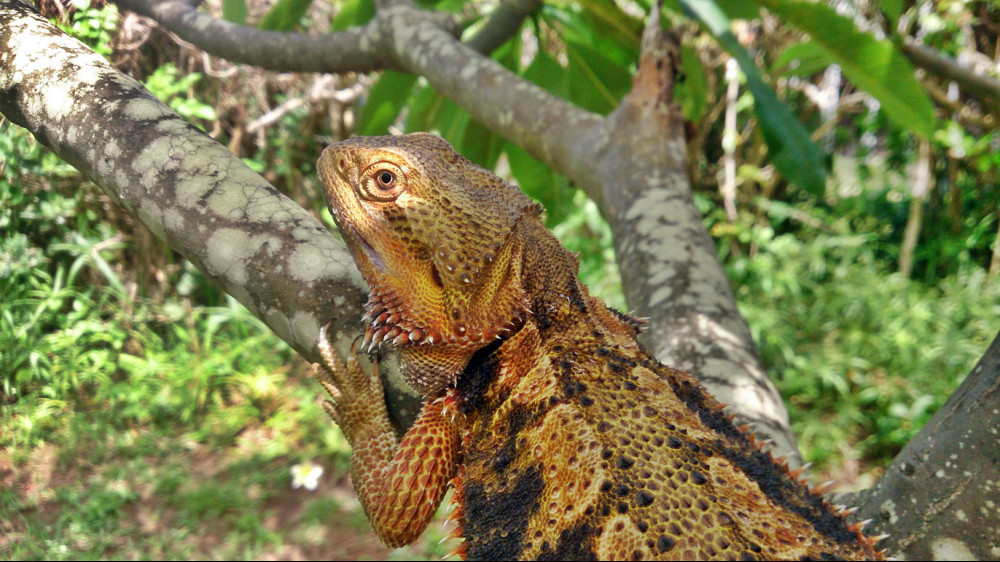The Behaviour of a bearded dragon can be quite interesting at times, but other times they can be cute or funny. The thing is most of the time we do not know what the behavior means, and then it can actually scare us and make us worry about them. This is why I have composed a list of their behaviors and what it is that they mean. This can set you at ease, help fix problems or let you know if something might be wrong.
Bearded Dragon Puffing Out Beard/Black Beard
Although both the male and female bearded dragon makes use of this ‘technique’, it is mostly used by the male. The females will do this to tell others to stay away. They will also do this if they are threatened and they are trying to look bigger to scare off whatever is threatening them. Males do use this technique as a defense, same as the females, but they have other uses for this as well, one of them being, to establish hierarchy. Males will have a black beard along with head bobbing to establish territory or to look bigger when he is preparing to fight with another male, which will return the gesture unless he is submitting. They will, furthermore, combine head bobbing and black beard to get mating approval from a female.
Take Note! Males and females will, moreover, also get a black beard when they are Ill or in pain. If the black beard persists for more than 5 hours, it is most likely due to illness and not behavior.

Bearded Dragon Head Bobbing
Head bobbing is an up-and-down movement of the head done by both males and females. It can be done either fast or slowly. It furthermore, can be combined with other behaviors like bearding, stomping, and the waving of the arms. A combination of these behaviors or a lack of certain ones can mean different things.
DOMINANCE: Fast head bobbing along with bearding is a sign of dominance (Sometimes the bobbing will lead to stomping). They do this when another bearded dragon has entered their territory and they want them gone. The other dragon will either submit, which is done by slow bobbing along with the wave of an arm, or they will return the bearding and fast bobbing, which is him saying he wants to fight for the territory. This applies to only males. Females do not really assert dominance with this type of behavior, their hierarchy is determined by their size, but sometimes they do not get along and need to assert their hierarchy. Females will have similar behavior when they assert dominance, but females will either get along or go straight to fighting. This does not mean there will not be any of the above-mentioned behavior.
MATING: The male mating ritual consists of the male trying to impress the female by bearding and bobbing really fast. If the female accepts him as a mate she will slowly bob about 2-4 times while waving her arm. When she doesn’t accept she will either run away or show dominance toward the male.
Bearded Dragon Waving
Bearded dragon arm-waving consists of them standing high on three legs or leaning against something in order to wave. Waving is when they lift one of their front legs in the air and move it in a circular motion. Why do bearded dragons wave? There are a few reasons for this behavior…
Submission: When one dragon is bigger or stronger than the other, the smaller one will submit by waving its arm at the dominant one. A slow or fast 2-4 bobs will usually accompany this behavior.
Mating: When a female is accepting a male for mating they will wave their arm along with a few slow bobs. Sometimes they will wave their arm to show another dragon that they know they are there. If there are no other dragons, animals, or reflections of them present, the wave can be directed toward you. It is kind of like saying “Hi how are you”, or “Hi I know you are there”.
Bearded Dragon Raised Tail
The younger ones raise their tails when they hunt and the adults do raise their tails for alertness during the breeding season, and all dragons will sometimes raise their tails when they are happy. (Please note that sometimes they will not do it even if they are happy.)
Bearded Dragon – Digging
This is when your dragon will start digging holes in the ground or trying to dig on the floor. They will dig to create a more comfortable basking area. Your dragon will sometimes do weird things, but this is absolutely normal. If it is a female and she is pregnant, she will dig for a place to lay her eggs.
They will sometimes dig to go into brumation if they are old enough. (Semi-hibernation). This action makes it a lot easier to sleep while regulating their temperature. If you really want to, you can put in a blanket to help make it easier to sleep.
If they dig it might be because they are trying to escape their enclosure or to get something outside the enclosure that they saw. In addition, it can be because they are trying to escape from something or another bearded dragon in the enclosure.
A female bearded dragon can become gravid with or without a male bearded dragon, but if there is no male the eggs will not be fertile. The female will become egg-bound (Dystocia) if a place where she can lay her eggs is not provided.
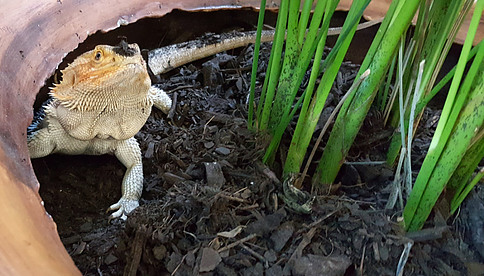
Bearded Dragons Laying on Top of Each Other
This behavior may make it look like they are great friends and companions, but it is actually the opposite. This is a sign of dominance. This is survival of the fittest in the animal kingdom and bearded dragons need UV rays to survive and when they lay on top of each other the one at the bottom does not get the much-needed light and can die if not separated. Cohabitation is NOT recommended when it comes to bearded dragons as they can get along fine for some time and then suddenly turn on each other.
Bearded Dragon Mouth Open/Gaping
This is exactly as it sounds. This is when your bearded dragon sits with its mouth open and not close. From the side, it looks like a gap.
A bearded dragon will open his/her mouth to allow cool air to lower its temperature. They have to do it this way because unlike us they cannot sweat at all. When they reach their ideal body heat they open up their mouths to regulate their temperature so they do not overheat. This will normally happen when basking. Sometimes they will also do this if they have a mouth disease, but do not worry; this is a very common behavior. An open mouth that goes along with heavy breathing is a sign of major concern. If your dragon does this regularly, it would be a good idea to visit the vet.
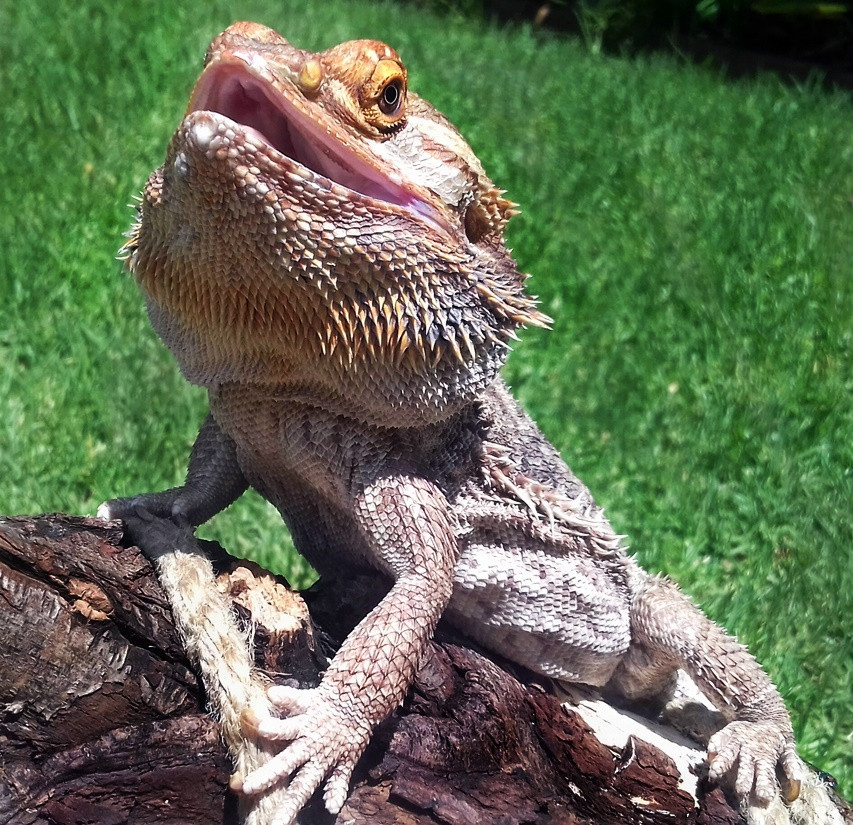
Bearded Dragon Yawning
A bearded dragon will usually yawn after waking up from a nap or after lights on in the morning. It is very common. They yawn by puffing out their beard several times and after that, they will open and close their mouths a few times. Sometimes they will yawn during the day as well and this is not to be concerned about. Just like us, they yawn when the air is thin or dry.
Bearded Dragon Tail Twitching
This is when your dragon’s tail twitches (similar to a cat’s tail.) If your dragon does not do this it does not mean that there is something wrong because some dragons do and some don’t. They will do this when it is breeding season. In addition, it can also happen if you are petting them and they do not want to be petted. This is, furthermore, a common behavior when they are hurt. Twitching can also be a sign of them developing MBD, which they get if they have a lack of calcium in their bodies. Always make sure your bearded dragon is receiving his/her supplements.
Bearded Dragon Basking
Basking is always needed for your bearded dragon. Bearded dragons use this behavior to regulate their inner and outer body heat. For proper metabolism, bearded dragons will need to get a temperature of 95°F – 110°F since they are unable to generate their own body heat. Dragons get their body heat from their environment and that is why they have to bask. Basking can be recognized easily. It consists of your bearded dragon sitting under their basking light; sometimes they flatten their bodies and turn its skin darker for optimal heat absorption.
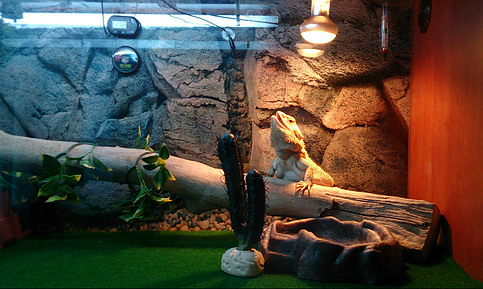
Bearded Dragons and Brumation
The meaning of brumation is actually a form of hibernation but not exactly the same thing. This is when they eat all throughout the summer and eat less during the winter. In winter they will sleep more than usual, but they will still wake up and eat. After winter they will reset their clocks and do things they have never done and will not want to do things they did before winter. This is when they “start anew” and will go into breeding with a new face. When bearded dragons live out there in the wild, they will brumate when the food is scarce, when the temperature drops, and when the days shorten. They can sleep anywhere from a day to a month at a time before waking up to eat, drink, and so on. If they are healthy dragons there is nothing to worry about, this is normal. During this time there must always be water in the tank for when they wake up and their temperatures should be kept consistent. Food should also be made available if they want to eat something.
The signs for brumation:
- Burrowing under their substrate or staying in their cave
- Decreased appetite
- Avoiding their basking light
- Not wanting to be handled
- Sleeping a lot
- Decreased activity
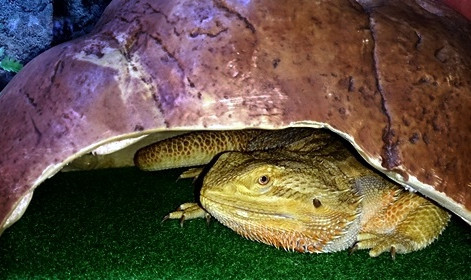
Bearded Dragon Color Change
This behavior is when the dragon will change skin color, not the beard color. Changing beard color and changing body color are two completely different behaviors. They will do this if they grow or shed. They will get more colorful after every shed till they are about 1-1½ years old. They get more color as they grow.
Their skin will darken when they are cold and want to absorb heat. They will also darken their skin along with black stripes on the belly when they are stressed out. Their skin color will, furthermore, change in color depending on their emotions, for instance, a happy dragon will be bright in color whereas an ill dragon will either be pale or dark in color.
Bearded Dragon Eye Bulging
Bearded dragons bulge their eyes for a number of reasons. Some of these reasons are unknown, but some are. One reason for this behavior is when their eyes are shedding and they are trying to loosen the skin or if the eye is itching. Sometimes they bulge their eyes before or after yawning, but if they constantly bulge their eyes or they do it for longer than 30 minutes, please consult a vet, because something can be seriously wrong.
Bearded Dragon Glass Surfing
Bearded dragons glass surf for multiple reasons, those reasons being that there might be something outside the cage they really want or something in the cage they want to get away from. They, furthermore, glass surf if they are threatened and want to get away or if the cage is too small or too hot and they want out. Another reason for this behavior is if they want to get your attention so that you can pick them up and give them love. This can seem quite cute when they are doing it but can have dangerous consequences. This behavior can lead to them cutting or injuring themselves on the glass and its edges.
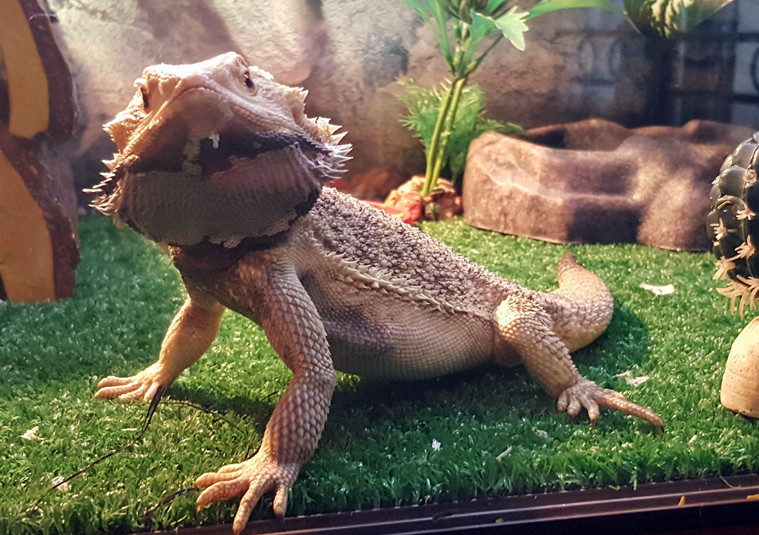
Bearded Dragon Hissing
A bearded dragon will usually make no sound, but if they are threatened, they may hiss and this is a sign of aggression. They might do this if they have an infection and it would be best to see a vet.
Bearded Dragon Flatten Out
A bearded dragon can flatten its body to make itself look bigger. This is a sign of aggression/passive that is displayed when threatened or if they want to be away from everyone and everything. If they are bathing they may do this to absorb the heat, or if the water is too deep they will puff themselves full of air to stay afloat.
When a bearded dragon is older they will use this behavior to collect more heat from the sun or lamp they have and this will help them raise their body heat, but if they do this constantly it means your heat source is too cool and that you have to make the basking spot hotter or bring the lamp/bulb closer. You can also increase the watt of your lamp/bulb. When their bodies reach the ideal temperature they will go to the cooler side of the cage to cool down.
Dragons will also flatten, inflate and rotate their body when exposed to another dragon and then they will circle each other with their bodies flattened, inflated, and rotated. This is when they are getting ready to fight for their territory. Bearded dragons will first try and scare each other off with other behaviors before revolving to a fight, seeing as fighting can lead to grave injuries or to their death.
Bearded Dragon Licking
Licking is when they flick out their tongs at objects and so forth, literally giving them a quick lick. This behavior is similar to that of a dog marking its journey. They lick things to remember them and their smell. When something new is introduced to them, they will constantly lick it to get used to it and remember it. They, moreover, lick things to discover the presence of others in order to make sure it is safe.
Rubbing
A bearded dragon will rub against everything in their enclosure to loosen skin when shedding. If they do this after shedding it means that there is skin that failed to come off when they were shedding. This can become a huge issue, especially if it is on the toes or legs because these pieces of skin can cut blood circulation leading to the loss of those limbs. Regular warm baths will help to loosen old skin. There are a few reptile products out there that also help with this issue.
Bearded Dragon Shedding
This happens when they are getting too big for their skin and need new ones. Shedding is also because of health, growth, and humidity. The younger ones do this a lot more often than the adults because they do a lot of growing. They will become more colorful after every shed. When they shed moisture and fog and so on come in between the new and old skin and that is what is lifting it. Give your dragon its space during this time, but give them regular baths to help with the process. DO NOT pull the skin off, because it can lead to serious injury for your dragon. They will get it off themselves; only assist if it is absolutely necessary. (Assistance consists of giving them lukewarm baths and using reptile products designed for these matters. Read more about Bearded Dragon Shedding
Their behavior might change during shedding, some will even become grumpy or nippy, have a black beard, or become restless and not eat that much. If these symptoms continue after a shed, please consult with your vet.
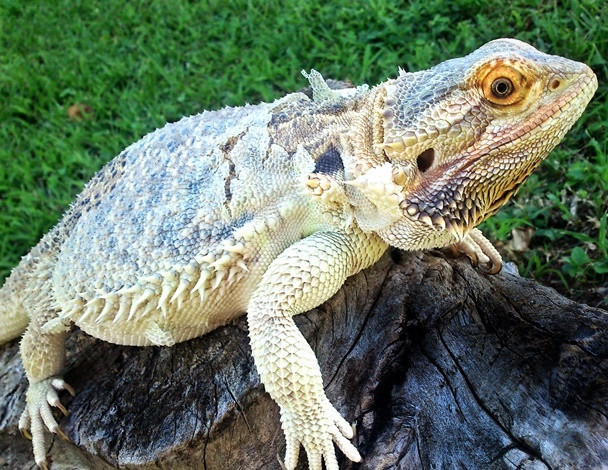
Stamping
This is when the dragon bobs so fiercely that his/her feet literally stamp on the ground. This behavior is carried out mostly by males, but sometimes a female will do it as well. Stamping usually accompanies a dragon showing dominance, because that is when they bob the most. It can also be shown during mating.
The Behavior of a Pregnant Bearded Dragon Female
There are a few signs and behaviors that accompany a female who is pregnant. They are as follows:
- A sudden increase in appetite followed by a sudden loss of appetite.
- Constant digging no matter where they are.
- More active, looking for digging places.
- Sudden weight gain, due to eggs and sudden increase of appetite.
- Less interest in basking.
- Aggression towards other dragons and animals.
- They do not sit still when they are getting petted and given love.
These are the most noticeable behaviors and signs of a pregnant female, but there might be other signs or behaviors. Remember each Bearded dragon is different and will do different things.
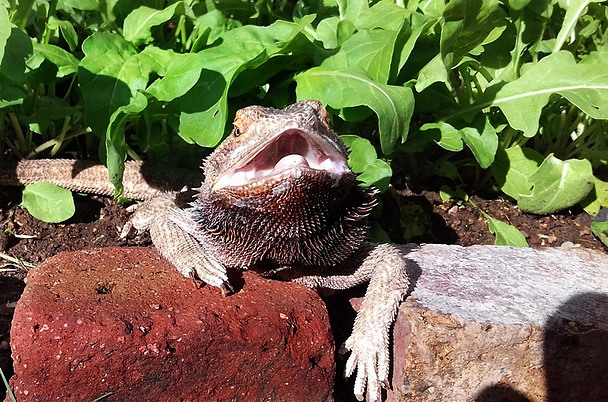
The Behavior of a Sick-Bearded Dragon
A combination of the following behaviors could be a sign that your beardie is ill and that he/she needs to see a vet.
- Constant black beard.
- Loss of appetite for days.
- Less active than usual.
- Vomiting
- Constantly lying in the same place.
- Droopiness
- Pale or dark skin color.
- Constant gaping/gasping when not basking.
- Constant eye-bulging
- Aggression when no one or nothing is around.
- Twitching
- Limping
- Diarrhea
- Constant pushing and lifting of the tail by the back legs, but not pooping.
- Lethargic
Do Bearded Dragons Bite?
Yes, they do. If bearded dragons bite each other it is a clear sign of aggression. If your bearded dragon bites you it is clear that the previous owners did not look after her/him nicely or it is just not tamed, but if it was the previous owners then it must have learned not to trust. This behavior can be defeated by just simply putting on CLEAN gloves and taking them out of their cage to be petted every day. After a few days, you can get rid of the gloves if you are prepared and if you think you and your dragon have grown a bond. This will help the bearded dragon grow trust in humans. (It would be best if you start with short periods, then you can do it longer.) Bearded dragons love being held, and petted and do not really have any aggression in general.
Another way to tame them is by holding them in a soft blanket and petting them through it.
